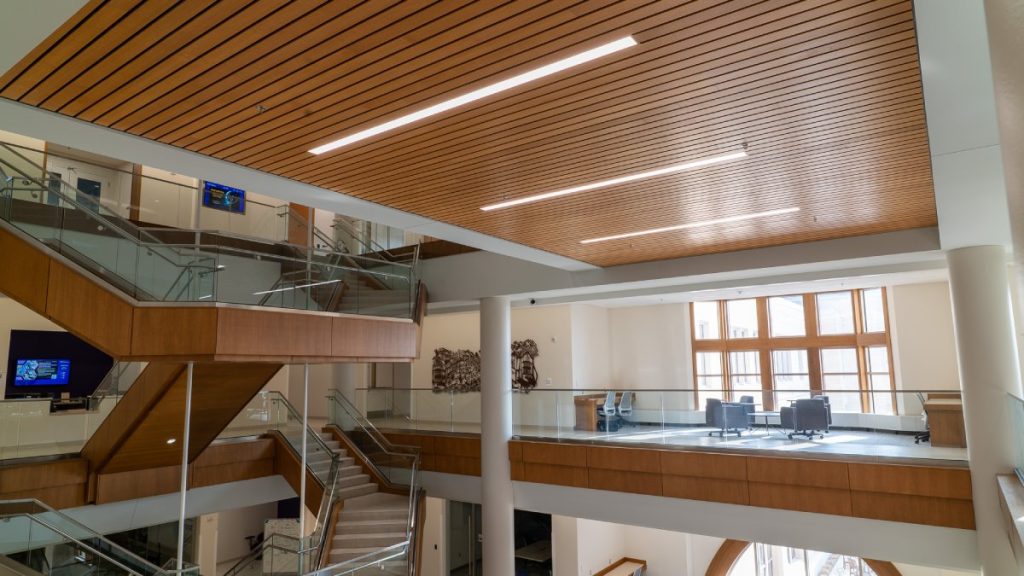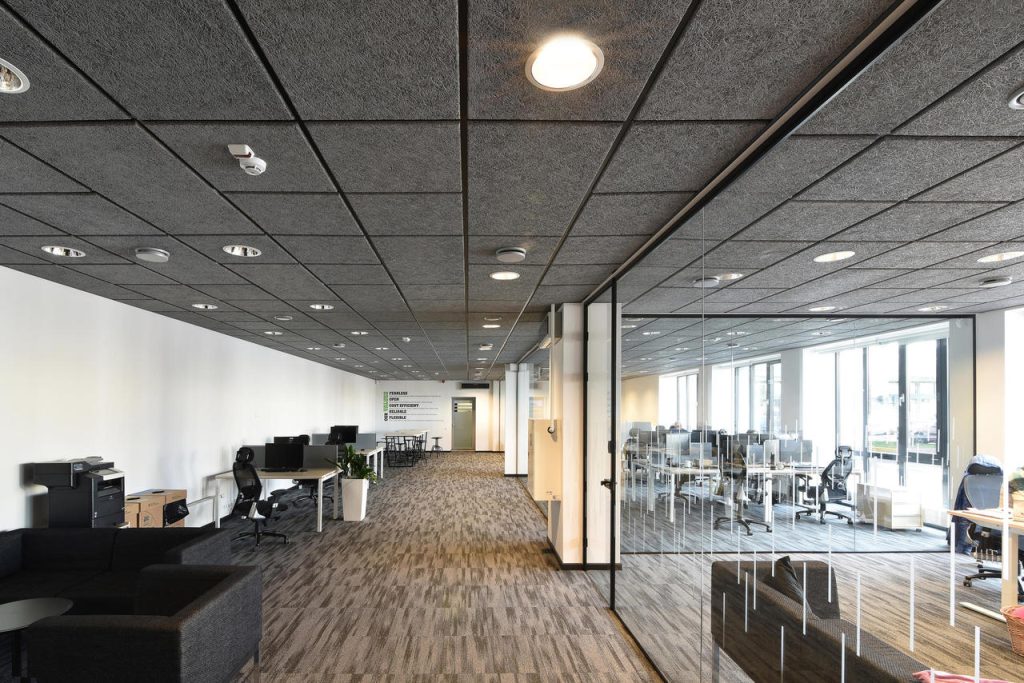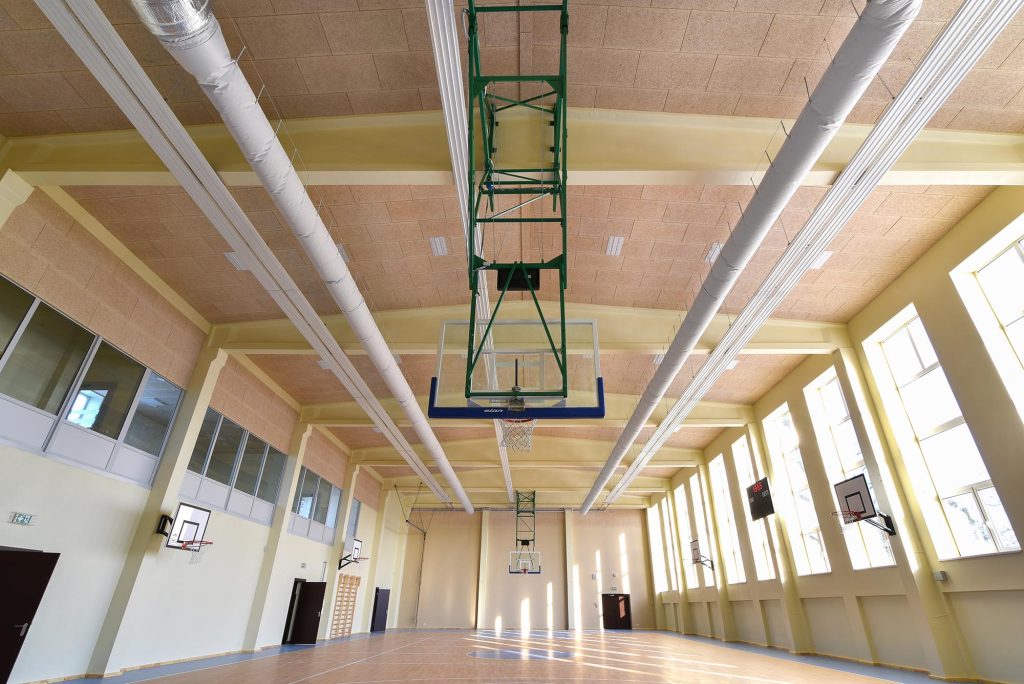
Architecture and the materials used to build it have always been intrinsically linked. The stone temples of antiquity gave way to the steel and glass skyscrapers of the 20th century as the materials available to designers and builders continued to expand and evolve. In today’s architectural material innovation, architects have a wider range of access to innovative building materials than before. This allows them to push the boundaries of design while meeting stricter sustainability and performance requirements, elevating the role of architectural materials in new ways to successfully balance form and function.
Architects and engineers are using a growing arsenal of new and advanced building materials that successfully balance form and function with environmental stewardship. In this article, we explain how they’re making the most of engineered wood, acoustic metamaterials, and other new high-performance architectural materials in their practice today.
High-Performance Materials for Modern Needs
The needs of modern buildings are changing. Hybrid workplaces, wellness-driven design, and the drive toward net-zero energy use are just a few trends that have a direct impact on what materials are used in architectural construction. The main point to take away from these changing needs is that the materials architects use must be both high-performance and flexible in terms of both form and functionality.
The list of high-performance criteria can be long: better sound control, lightweight and durable design, favorable fire ratings, and more. The following high-performance material solutions are helping to redefine interiors as well as exteriors in ways that make the most of today’s modern demands.
Acoustic Metamaterials
With some of the most exciting growth in acoustics comes acoustic metamaterials. While traditional acoustic building materials (panels and ceiling tiles) are still effective, newer solutions like acoustic metamaterials provide greater precision in controlling how sound behaves in a space.
These sound-absorbing building materials are engineered to control sound waves at the micro-structural level to manipulate wave propagation. As a result, architects have an opportunity to control sound in more targeted ways. This can include sound redirection, damping, and isolation for very specific frequencies and frequencies alone. Applications for metamaterials range from office spaces and break rooms to performance halls where acoustic precision is important.
Engineered Wood
Engineered wood has always had a major role to play when it comes to architectural products and building materials. Not only is it aesthetically pleasing with the warmth and look of natural wood, but it has increased structural stability. Newer iterations of engineered wood boast strong acoustical qualities for ceiling and wall applications in schools, offices, and performance spaces.
At ASI Architectural, Fusion and Audition are two lines that demonstrate how wood materials can address the needs of architects and building owners.
Perforated Metal
Perforated metal ceiling panels are also a great option to consider when it comes to modern aesthetics and delivering sound control capabilities. The perforations in these ceiling panels allow sound waves to travel through to an absorbent backing in a way that provides sound control performance and a sleek aesthetic. Perforated metal ceiling tiles are especially effective in corporate lobbies, airport terminals, auditoriums, and other places where reducing ambient noise is a high priority without sacrificing a sleek modern look.
Learn more about options like ASI Architectural’s Microperf Metal.
PET Felt
PET felt is a unique example because while it is not a core ASI Architectural product, it’s one of the fastest growing sustainable design solutions. Made from recycled plastics, PET felt is lightweight and yet extremely durable and impact-resistant. PET felt is typically used in baffles, clouds, and wall coverings. In projects where weight and sustainability are key, this sustainable material is often the answer.
Learn more at our sister company: Acoustical Surfaces – Acoustic Panels
Lightweight Yet Durable Options for Large Spaces
Materials that are high-strength and lightweight are key for large-span ceilings and suspended installations where there are concerns of both durability and safety. In addition to smaller scale interior spaces, many modern architectural projects incorporate very large open areas with wide spans. This can be anything from airports to atriums and stadiums. When working with larger spaces, a common theme is the need for lightweight construction materials that are just as durable and stable over the long term. Architects and engineers often have to work to reduce weight where possible while also making sure these spaces meet fire ratings and acoustic performance requirements.
Metal Panel Systems
Aluminum architectural panels are a great example of a material that provides high strength while also being lightweight. Aluminum is also resistant to corrosion and weathering, making it ideal for exterior applications as well as indoor ones. These panels can also be backed by acoustical solutions for acoustically optimized environments that don’t have to sacrifice style.
Composite and Fiber Panels
Composite architectural products like wood fiber ceiling panels open up a ton of design possibilities because they can often incorporate a wide variety of performance elements. The tradeoff can be that these products are often heavy and require extra engineering consideration to make sure they work from a structural standpoint. A new wave of hybrid material systems can now offer a way to find the right balance between strength, sound absorption, and easy installation.
Some composites, like ASI Architectural’s StrandTec, offer excellent sound absorption but are considerably heavier.
As a result, they require additional engineering consideration.
Working with Engineers on Feasibility and Specs
Material innovation has opened up plenty of creative freedom for architects and designers. At the same time, working closely with both structural and acoustic engineers is more important than ever. It’s not just about the materials that look the best or provide the best acoustical performance, it’s also about making sure the right material choices result in a project that works in terms of both compliance and long-term performance.
Balancing Aesthetics with Technical Requirements
Aesthetics and design are often what architects start with. Engineers help them take that initial vision and make it a reality by calculating the load capacity, factoring in structural acoustic solutions, and double checking that the final product meets fire-rated requirements and codes.
A great example of this is an architect that envisions a ceiling filled with suspended wood panels. Engineers are then able to figure out whether any of those wood panels would have to be fire-rated architectural materials or if a lighter weight alternative would work.
Using Digital Modeling for Material Testing
Today, CAD and BIM have become the standards when modelling how materials will work in space before installation even begins. This is because architects can actually use the CAD platform to conduct simulations of acoustical absorption, test structural loads, and even model environmental performance.
If you’re considering ASI Architectural’s Wood Grille, Baffle Ceilings, or Cloud Systems, then detailed spec sheets as well as digital modeling support is available to help ensure your design works with the engineering and construction considerations for your space.
The Future of Eco-Friendly Architectural Innovations
Looking ahead to the future of architectural practice and design, much of the innovation will revolve around eco-friendly architectural innovations. Green building certifications like LEED and WELL are big drivers of material choices, and the demand for sustainable design solutions is only increasing. Materials like PET felt, bio-based composites, and advanced sound-absorbing materials are already helping architects create spaces that are healthier and more comfortable while also being better for the planet.
Another area of growth is modular architectural materials that allow for faster installation, less waste, and greater adaptability in multi-use environments. These materials are also often paired with fire-rated and acoustically engineered systems to create buildings that are as safe and as functional as they are beautiful.
The Next Chapter in Architectural Design
The fact is, architects today are really working in the age of architectural material innovation. When it comes to engineered wood and perforated metal ceiling panels, acoustic metamaterials, and hybrid composite options, there’s never been more opportunity for architects to design with materials that can truly push the limits of performance, sustainability, and aesthetics. Architects who take a performance-driven approach when it comes to architectural materials and who work closely with engineers to ensure balance between vision and feasibility will be the ones who create buildings that are beautiful, acoustically optimized, and sustainable. As the focus on eco-friendly architectural innovations continues to accelerate, the industry will continue to look to new frontiers in the materials we use. After all, the materials architects build with have a huge role in not just how the space looks, but how it feels and how it performs for generations to come.
Whether it’s a concert hall, a university campus, or a corporate headquarters, the right material choice speaks volumes to a project’s success. At ASI Architectural, we deliver high-performance, sustainable, and acoustically optimized solutions that help architects bring their visions to life.
Contact us today to learn how we can support your next project.







